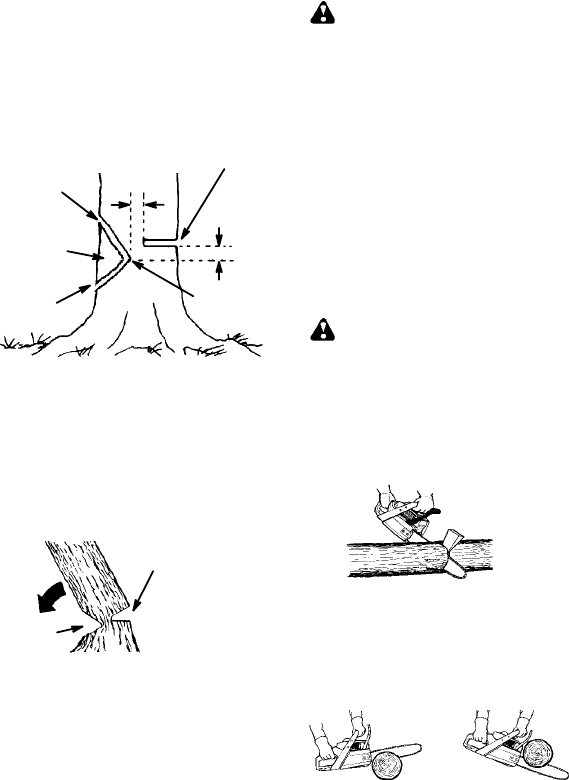
11
FELLING LARGE TREES
(6 inches/15 cm in diameter or larger)
The not ch method is used to fell large trees.
A notch is cut on t heside ofthe treein thede-
sired direction of fall. After a felling cut is
made on the opposite side of tree, t he tree
will tend to fall into the notch.
NOTE: If the tree has large buttress roots,
remove thembefore making the notch. If us-
ing saw to remove buttress roots, keep saw
chain from contacting groundto preventdull-
ing of the chain.
NOTCH CUT AND F ELLING THE
TREE
S Make notch cut by cutting the top of the
notch first. Cut through
1/3 of the diameter
ofthe tree. Nextcomplete thenotch by cut-
ting the bottom of the notch. See illustra-
tion. Once the notch is cut remove the
notch of wood from the tree.
Notch
First c ut
Second cut
Final (
f
elling) cut here.
2″ (5 cm) above center of notch.
5cm
5cm
Hinge
S After removing the wood from the notch,
make the felling cut on the opposite side of
the notch. This is done by making a cut about
two inches higher than the center of the
notch. T his will leave enough uncut wood
between the felling cut and the notch to form
a h inge. This hinge will help prevent the tree
from falling in t he wrong direction.
Opening
of felling
cut
Closing
of
notch
Hinge holds tree on stump and helps
control fall
NOTE: Before felling cut i s complete, use
wedges to open the cut when necessary to
controlthe directionof fall. Toavoid kickback
and chain damage, use wood or plastic
wedges, but never steel or iron wedges.
S Be alert to signs that the tree is ready to
fall: cracking sounds, widening of the fell-
ing cut, or movement in the upper
branches.
S As tree starts to fall, stop saw, put it down,
and get away quickly on your planned re-
treat path.
S DO NOT cut down a partially fallen tree
with your saw. Be extremely cautious with
partially fallen trees that may be poorly
supported. When a tree doesn’t fall com-
pletely,set thesaw asideand pull downthe
tree with a cable winch, block and tackle,
or tractor.
CUTTING A FALLEN TREE
(BUCKING)
Bucking is the term used for cutting a fallen
tree to the desired log length.
WARNING: Do not stand on the log
being cut. Any portion can roll causing loss
of footing and control. Do not stand downhill
of the log being cut.
IMPORTANT POINTS
S Cut only one log at a time.
S Cut shattered wood very carefully; s harp
pieces ofwood could beflung towardoper-
ator.
S Use a sawhorse to cut small logs. Never
allow another person to hold t he log while
cutting and never holdthe log with your leg
or foot.
S Do not cut in a n area where logs, limbs,
and roots a re tangled. Drag the logs into a
clear area before cutting b y pulling out ex-
posed and cleared logs first.
TYPES OF CUT TING USED FOR
BUCKING
WARNING: If saw becomes
pinched or hung in a log, don’t try to force it
out. Youcan losecontrol ofthe saw resulting
in injury and/or damage to the saw. Stop the
saw, drive awedge ofplastic or wood intothe
cut until the saw can be removed easily. Re-
start t h e saw and carefully reenter the cut.
Do not attempt to restart your saw when it i s
pinched or hung in a log.
Turn saw OFF and use a plastic or
wooden wedge to force cut open.
Useawedgetoremovepinchedsaw
Overcutting begins onthe topsideof thelog
with the saw against the log. When overcut-
ting use light downward pressure.
Overcutting Undercutting
Undercutting involves cutting on the under-
side of thelog with top ofsaw against thelog.
When undercutting use light upward pres-
sure. Hold saw firmly and maintain control.
The saw will tend to push back toward you.


















